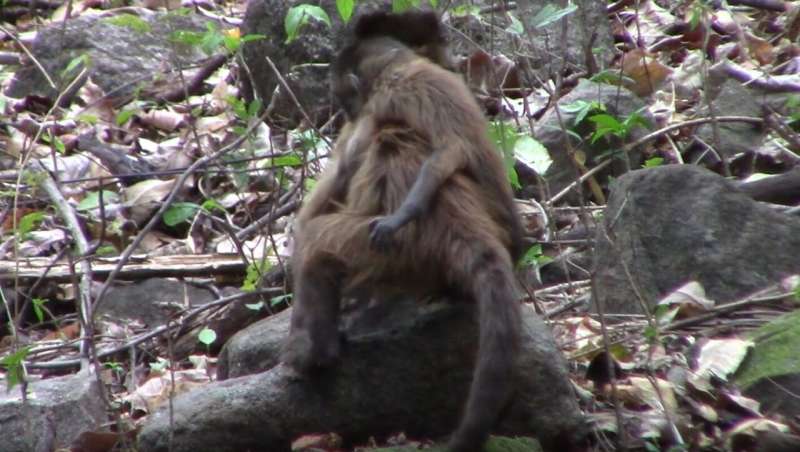March 7, 2023 report
This article has been reviewed according to Science X's editorial process and policies. Editors have highlighted the following attributes while ensuring the content's credibility:
fact-checked
peer-reviewed publication
trusted source
proofread
Compassionate disabled infant care from a wild capuchin monkey mother

High up in the canopy of the Brazilian rainforest, clinging unsteadily to its mother's back, a wild newborn bearded capuchin monkey with a non-functioning left leg was beating the odds. Observations of the disabled infant monkey and his mother gave researchers a rare glimpse into care in an arboreal environment.
According to the researcher's recorded observations, the infant's leg showed no external signs of damage but presented as a dislocated knee, cause unknown. Unable to use the left foot for gripping, the infant was often unstable on the mother's back as she moved about. The mother was seen to frequently stop and reposition the young capuchin, estimated to be less than a month old, adjusting it much more often than observed in another mother with a similar-aged infant.
The instability also happened whenever the mother used stones to crack open encased fruits. In these instances, the mother was seen raising her tail, an unusual behavior for a capuchin as pressing the tail to the ground is typically done for added leverage. The researchers believe the tail raising may have been an effort to prevent the infant from falling off during the abrupt maneuvers.
When breastfeeding, the infant received additional repositioning support when needed, though it was seen to nurse unassisted at times.
An adult male was observed multiple times with the infant on his back, sometimes resting close to the mother and at other times carrying the infant when the mother was not in view. He was seen adjusting the infant's position on his back when the little one had difficulty hanging on.
In the study, the researchers point out that while the evolutionary origins of injured care are unclear, recording observations in various nonhuman primates can offer insights. They suggest the difficulty of carrying a disabled infant high up in the trees may help to explain the scarcity of care reports in new world monkeys. Additionally, they consider how being on the ground and having increased bipedality may have positively contributed to the evolution of care behaviors in more terrestrial primates.
The observations were made by researchers with the Neotropical Primates Research Group (NeoPReGo), a non-profit NGO founded by field biologists to support long-term primatological research in Brazil. They published their paper, "Life and death of a disabled wild capuchin monkey infant," in the journal Primates.
Unhappy ending
Unfortunately, the young capuchin did not make it past eight weeks. The researchers did not observe the circumstances but continued to monitor the mother's behavior. They noted a marked change in her behavior as she carried the lifeless body through the canopy. At times she "held it tight against her body with one hand," and at other times, "...held on to the tail or another appendage, letting the body dangle as she locomoted." She continued to groom her child, despite the smell of decomposition.
Where she had previously allowed members of the group to approach and interact with the infant, she now shunned contact, especially when other members attempted to touch or engage in grooming of the corpse, eventually moving further away from the group.
The effort involved after death seen in primate mothers is considered an evolved measure of care to prevent abandonment during temporarily unconscious or unresponsive conditions, according to a hypothesis of "unawareness" cited in the paper. In this case, a mother carrying nearly 16% of her body weight in one hand while traveling over a kilometer through the trees and foraging at a reduced capacity may be following a survival strategy of illness care that links many primates. Eventually, the extended efforts overcame the mother's physical ability or simply reached a point of unavoidable awareness—she let go while leaping between trees, allowing the lifeless body to fall freely to the ground below.
More information: Tatiane Valença et al, Life and death of a disabled wild capuchin monkey infant, Primates (2023). DOI: 10.1007/s10329-023-01052-1
Journal information: Primates
© 2023 Science X Network


















